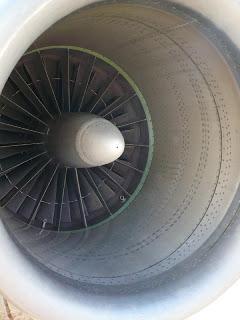Over the years, I've poked fun and made light of more than a few questions and comments heard from passengers. Some have been silly, some unexpectedly insightful and others genuinely helpful, but a recent question from a reader highlighted the need for some clarification.
If you have a genuine concern...don't hesitate to ask.
Generally speaking, passenger questions fall into one of three categories: 1) Common questions easily explained and needing no further investigation. 2) Questions that can be easily explained, but require some investigation by the crew...just to make sure, and 3) Questions or comments that bring potentially serious concerns to the crew's attention.

The first category is both the least serious and the most common, including question like I've answered in two recent posts: "What is that thing on the MD80 nose wheel?" and "Something odd about MD80 flight controls?" In these posts, I explained the spray deflector installed on the MD80 nose gear assembly and gave a short systems lesson on flight controls to explain why the elevators on an MD80 often move in opposite directions...that isn't normal on most airplanes. There are dozens of other common examples...the clunk heard when the landing gear comes up or down...the scrapping sound heard as the slats retract...the repeated thump of flight controls blowing in the wind while on the ground...all questions that I hear almost every time I go to work...all questions I can answer confidently without investigation.
 I had a passenger recently who stopped by the cockpit on his
way off the jet to ask why we had elected not to use the right engine. He was completely sincere and at first, I
thought maybe he was referring to the fact that we had shut the engine down
during taxi-in. It is common to taxi on
one engine to conserve fuel. He
explained that his seat was located a few rows forward of the right engine and
that he had a clear view into the inlet.
"It never moved," he told us.
I explained to him that the first thing you see when looking into the
inlet of a Pratt & Whitney JT8D are the inlet guide vanes...their purpose
is to guide the air smoothly through the engine and they don't move. The first stage fan blades are visible past
the inlet guide vanes, but they're moving so fast that they don't look like
they're moving, but I assure you they are.
I tried very hard to convince him of this, but I'm pretty sure he left
convinced we had just flown an entire flight on one engine!
I had a passenger recently who stopped by the cockpit on his
way off the jet to ask why we had elected not to use the right engine. He was completely sincere and at first, I
thought maybe he was referring to the fact that we had shut the engine down
during taxi-in. It is common to taxi on
one engine to conserve fuel. He
explained that his seat was located a few rows forward of the right engine and
that he had a clear view into the inlet.
"It never moved," he told us.
I explained to him that the first thing you see when looking into the
inlet of a Pratt & Whitney JT8D are the inlet guide vanes...their purpose
is to guide the air smoothly through the engine and they don't move. The first stage fan blades are visible past
the inlet guide vanes, but they're moving so fast that they don't look like
they're moving, but I assure you they are.
I tried very hard to convince him of this, but I'm pretty sure he left
convinced we had just flown an entire flight on one engine!
The second category includes questions that I am relatively sure pose no danger to the flight and can, with relative certainty, be explained to a concerned passenger without investigation. But if there is even the slightest possibility that something could actually be wrong with the airplane, I always take a closer look and verify the condition of the jet.
For instance, at least once a month in the winter, a passenger will tell one of the flight attendants that something is leaking from the wing. Rest assured...when you share something of this nature with the cabin crew, they will absolutely pass your concerns on to the cockpit, but the most likely culprit is deicing fluid. I am repeatedly amazed by the length of time it takes for deicing fluid to blow off the wings and airframe. If an airplane is deiced in Chicago and flown four hours to San Diego at roughly 500 miles per hour, there will still be fluid dripping off the wings after landing. Not only is the stuff as thick as molasses when cold, but a single drop looks like a flowing river in the airflow over the wing...easily mistaken for a severe fuel leak in direct sunlight.
The question can be easily explained, but requires investigation from the crew to make sure. Your pilots are continually monitoring fuel usage on any flight. They keep fuel logs and record the amount of fuel over each waypoint on the flight plan and compare planned fuel burn to actual several times an hour. Also, with fuel in multiple tanks, they verify that fuel burns evenly to prevent an excessive imbalance between tanks that could potentially exceed the operating limitations of the aircraft. All of this is happening even without a suspected fuel leak, but after such a concern is raised, extra time and effort will go into monitoring engine parameters and fuel usage. If there is a problem, and there almost never is, the crew will be aware it and on top of the situation.

The last category is exceedingly rare...a question that brings to light a potentially serious situation or discrepancy not already recognized by the crew. The real reason this sort of question is so rare is that the crew is almost always already well aware of anything genuinely serious. While the sea of cockpit instruments may seem foreign and confusing to anyone not trained to use them, they make perfect sense to the cockpit crew who is constantly using them to interpret the condition of the aircraft. Not to mention, modern aircraft are quite adept at monitoring themselves.
Also in this category would go questions about how the airplane is being operated...like failure to lower flaps on takeoff. I'm sorry to say this one has happened and the crash of Delta Air Lines flight 1141 in August of 1988 is a sad, but true example. DL1141, a Boeing 727-200, lined up on runway 18L and held on the runway to allow wake turbulence to dissipate from a previously departed DC-10. Once cleared to depart, the takeoff roll was normal, but as the jet lifted off the runway it began to roll violently, impacted the runway with the right wing tip, then struck an ILS localizer antenna array 1,000 feet past the end of the runway. Two of the four cabin crew members and 12 of the 101 passengers lost their lives. [1] [2]
The probable cause of the accident: "(1) The captain and first officer's inadequate cockpit discipline which resulted in the flight crew's attempt to takeoff without the wing flaps and slats properly configured; and (2) the failure of the takeoff configuration warning system to alert the crew that the airplane was not properly configured for the takeoff.
The Takeoff Configuration Warning System is a feature available on most Transport Category Aircraft that alerts the cockpit crew if they attempt to takeoff before properly configuring their aircraft. It's one of those things I always show kids when they visit the cockpit, because the MD80 I currently fly verbally tells the pilot what isn't set correctly..."stabilizer,brakes, flaps, slats" for example. Unfortunately, in the example of DL1141, the system did not work as it should and highlights the need for strict adherence to procedures and checklist discipline. As always, there is a long chain of events that leads to any accident. Anyone on that plane could potentially have been the link that broke a tragic sequence of events.
The original question that got me thinking about this subject came from one of my readers who wanted to know when it was appropriate to share concerns with the crew. I think the answer is that it is always appropriate. Your concerns are legitimate, even if easily answered. I strongly believe we should all be a part of the safety of flight. The bottom line here is that if you, as a passenger, have a concern about the airplane, the weather, a fellow passenger or whatever else may be troubling you, don't hesitate to ask. The crew is almost surely on top of anything that may be wrong, but there is absolutely nothing wrong with making sure.
That said; if you ask me a question that I find to be amusing, entertaining or interesting in some way, don't be surprised if you read about it here.
